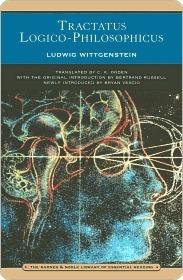More on this book
Community
Kindle Notes & Highlights
2.151 Pictorial form is the possibility that things are related to one another in the same way as the elements of the picture. 2.1511 That is how a picture is attached to reality; it reaches right out to it.
2.1512 It is laid against reality like a measure.
2.161 There must be something identical in a picture and what it depicts, to enable the one to be a picture of the other at all.
2.17 What a picture must have in common with reality, in order to be able to depict it—correctly or incorrectly—in the way that it does, is its pictorial form.
2.172 A picture cannot, however, depict its pictorial form: it displays it.
2.18 What any picture, of whatever form, must have in common with reality, in order to be able to depict it—correctly or incorrectly—in any way at all, is logical form, i.e. the form of reality.
2.202 A picture contains the possibility of the situation that it represents.
2.225 There are no pictures that are true a priori.
3.01 The totality of true thoughts is a picture of the world.
3.04 It a thought were correct a priori, it would be a thought whose possibility ensured its truth.
3.11 We use the perceptible sign of a proposition (spoken or written, etc.) as a projection of a possible situation. The method of projection is to think of the sense of the proposition.
3.262 What signs fail to express, their application shows. What signs slur over, their application says clearly.
3.322 Our use of the same sign to signify two different objects can never indicate a common characteristic of the two, if we use it with two different modes of signification. For the sign, of course, is arbitrary. So we could choose two different signs instead, and then what would be left in common on the signifying side?
3.324 In this way the most fundamental confusions are easily produced (the whole of philosophy is full of them).
3.326 In order to recognize a symbol by its sign we must observe how it is used with a sense.
3.332 No proposition can make a statement about itself, because a propositional sign cannot be contained in itself (that is the whole of the 'theory of types').
again and again the individual case turns out to be unimportant, but the possibility of each individual case discloses something about the essence of the world.
(The logical scaffolding surrounding a picture determines logical space. The force of a proposition reaches through the whole of logical space.)
4.001 The totality of propositions is language.
Everyday language is a part of the human organism and is no less complicated than it.
The tacit conventions on which the understanding of everyday language depends are enormously complicated.
And it is not surprising that the deepest problems are in fact not problems at all.
4.01 A proposition is a picture of reality. A proposition is a model of reality as we imagine it.
4.015 The possibility
4.024 To understand a proposition means to know what is the case if it is true. (One can understand it, therefore, without knowing whether it is true.) It is understood by anyone who understands its constituents.
But in order to be able to say that a point is black or white, I must first know when a point is called black, and when white: in order to be able to say,'"p" is true (or false)', I must have determined in what circumstances I call 'p' true, and in so doing I determine the sense of the proposition.


